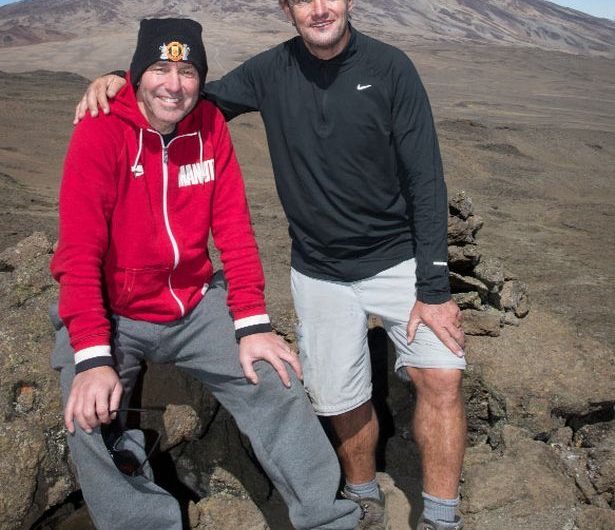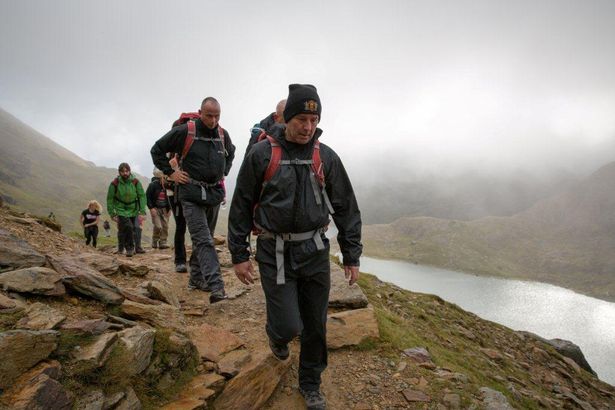Bryan Robson has climbed to the top of Mount Kilimanjaro, the world’s biggest free-standing peak.
On Thursday, the 56-year-old ex-England captain, together with his Manchester United colleague Kevin Moran, son Ben, and daughter Claire, completed the journey.
Due to the tough weather, five of the 25-man trek team failed to reach the peak.
The trekkers set out from camp at 11 p.m. on Wednesday night in order to reach the 5,895-meter summit by 5 a.m. on Thursday, walking through temperatures as low as -22 degrees with windchill.
The temperature was so high that the water in their backpacks froze, making it difficult to drink anything throughout the 10-hour hike, and many of the team members had trouble breathing owing to the high altitude.
Robson, who has been battling throat cancer, and his teammates have raised almost £30,000 for the Manchester United Foundation, and they intend to raise much more when they return to England.
 Manchester United Legend Climbs Kilimanjaro for Charity
Manchester United Legend Climbs Kilimanjaro for Charity
The charity collaborates with organizations such as Unicef, Francis House, a hospice for terminally ill children, and The Christie Charity, a prominent cancer treatment center, to give football instruction to persons with disabilities and to utilize football to engage youth in underserved communities.
‘I don’t believe I felt any sense of happiness when I got to the top first because I was just so crushed!’ said Moran, a former United teammate. But now that we’ve waited and slept for a time, you’re feeling a sense of accomplishment.
‘With the wind-chill factor, it’s -22C up here, so hurry up and turn that thing [the camera] off so we can go down!’
Summit Night
The trekkers left camp at 11 p.m. last night in temperatures as low as -22 degrees with windchill, and walked through the night in temperatures as low as -22 degrees with windchill – the water in their bags froze, making it difficult to drink anything during the 10-hour trek, and many of the team members have struggled with breathing due to the high altitude.
Here Bran Robson narrates how it all went down
Details how they climbed Mount Kilimanjaro
I haven’t even left the home yet, and the first obstacle I must overcome is deciding what to take.
Before flying to Tanzania, the party will fly from Manchester to Amsterdam. The problem is that following the expedition, I’ll be flying to Australia with my family to see the Melbourne Cup.
I’ll need two bags, one for suits and ties and the other for raincoats and ‘skins.’
We met with the head of Charity Challenge a couple times and went through all you need to know. Temperatures in Tanzania will range from 30 degrees to minus 20 degrees, so it’s best to prepare for the worst.
He also advised us to go with some of our clothing and walking boots in case our luggage were misplaced and we had to begin the hike without them.
Everyone arrives at the airport like packhorses at 4 a.m. We are a group of 28 people that completely fill the plane.
The journey to Amsterdam is uneventful, and we make our connection to Tanzania without difficulty. Our accommodation, the Kia Lodge, is a ten-minute drive away. It’s perched on a ridge near Arusha, with the savannah all around us. In the distance, you can see Mount Kilimanjaro.
The team leader advises that we hook up with someone, a “buddy,” who we would keep an eye out for on the walk in order to foster a sense of unity and team spirit.
Kevin Moran and I are sharing a room. The last time we shared a room was when I initially came at Manchester United in the 1980s. ‘BUDDY!’ we say as we hold each other.
We have supper and receive instructions on what to anticipate the next day, including temperatures and what to wear. We’ll also be moving out of our cozy log home and into tents, and we’ve been informed that early beginnings necessitate being prepared.
Detailed Itinerary – Day to Day
THE FIRST DAY: (Start altitude at Rongai Gate: 1,950m, finish at camp: 2,600m)
Breakfast is at 6.30 a.m., and the alarm goes off at 6 a.m.
The first thing you notice is that no matter how you pack your luggage, the item you require is always found near the bottom.
We board a bus for a five-hour journey to the summit. It appears to be enormous. At Rongai Gate, there is a check-in station where we sign in. A four-hour hike to the first camp lies ahead.
The terrain is difficult to navigate. Because it’s volcanic, it’s a combination of farming and woodland that eventually gives way to sand and rock. We take it gently due of the altitude, which will be one of our biggest issues. Kilimanjaro stands at a height of 5,895 meters.
As we stroll along, roughly 30 youngsters sprint by us on their way home from school.
They walk part of the way up the mountain while holding our hands, then return home. I’ll never know where they resided because we couldn’t see anything that looked like a house.
Before it becomes dark, we set up camp about 5 p.m. It’s funny that I hadn’t gone camping since I was 14 years old in high school. We have 84 porters travelling with us to assist with food and tent setup.
We organize our belongings and are advised to take care of our feet by taking off our boots, washing them, and talcing them. It was excellent advice.
Dinner is served at 8 p.m. The meal is excellent. Soup is served first, followed by a chicken dish. It’s unquestionably superior to I’m A Celebrity Get Out of Here!
After that, we converse outside beneath the stars, but it’s so chilly by 9.30 p.m. that everyone retreats to the tent for comfort.
We’d been taught to drink six litres of water per day and that, due to the severe change in temperature, it was important to clean oneself off with a wet wipe before going to bed, then half dress for the next day before going to sleep so that we woke up warm.
The result of drinking (or attempting to drink) so much water is that you wake up in the middle of the night wanting to pee.
Read more on where you poop and pee while climbing Kilimanjaro
Like the excellent friends we are, Kev Moran and I agreed that rather than waking each other up every time one of us wanted to go somewhere, we would go together. We’d just be missing our purses!
The trouble was that Kev hadn’t paid attention to the bit about wearing warmly.
I slept like a baby, but Kev couldn’t get enough of me and woke me up at 2 a.m. for a bathroom break. When we go outdoors, it’s really cold. I’m dressed, but across the room, Kev is yelping and whooping because he’d just put on his boxer shorts and boots, and it’s around minus 2 degrees outside, and he’s trying to urinate on the side of the world’s biggest free-standing mountain.
I couldn’t stop myself from laughing. He was a gorgeous blue color.
THE SECOND DAY: (From 2,600m to 3,600m)
We’re up for breakfast at 5.30 a.m. Porridge, bacon-flecked omelette, tea, and fruit juice It’s rather delicious. Kev appears to be a little worse for wear…albeit a little warmer.
We went on a four-hour hike. It’s a leisurely pace, and after an hour of respite, we’ll walk for another four hours.
We set up tent and have dinner together at 8 p.m. The soup is followed by a chicken goulash.
The weather had been quite hot. It was 28 degrees in the day, so you find yourself removing clothing as you walk, but we’ve been informed it’ll be 0 degrees and minus 2 degrees that night.
We make a point of reminding each other to take our pills. I take malaria medication, a Diamox tablet for altitude, and vitamin C. As we walk, we’re all carrying energy bars and gel sachets.
A few people have already complained about headaches, which are the most common sign of altitude sickness. Gwyneth, the doctor, goes about checking on everyone.
Claire, one of my children, and Ben, my son, are both going on vacation. Claire claims she wants her own tent, but after hearing some noises outside, she convinces her brother that he must stay in her tent with her so she may feel safe.
It’s amazing, though, because there are no creatures in sight as you stare across the lunar-like environment. All we see is a mouse running around camp in search of crumbs.
Kev is having trouble sleeping once more. He didn’t bring a pillow, so he’s sleeping on his jacket. When I wake up in the morning, he claims he’s tired of staring at me snoring while he can’t go asleep.
THIRD DAY: (From 3,600m to 4,330m)
Kev is brewing a cup of tea at 5 a.m. The porters are always there, and when the sun rises, we have a laugh and a conversation. Around 7 a.m., we have breakfast and set off on another four-hour hike.
The first two hours are a brutal ascent. As the effects of the altitude set in, a few people truly suffered.
We take a break for lunch at 1.30 p.m. and then relax in the afternoon. Dinner will be served at 7:00 p.m., then we will have a meeting to discuss how things will begin to become tougher.
It’s 14,000 feet above sea level. It’s – 4 degrees outside, so Kev and I head inside the tent to play cards. We’re really changing it up here, with Trumps followed by Rummy. Kev is the one who has the upper hand. I can’t afford to read since I don’t want to drain my head torch’s batteries. I’m going on the summit trek and don’t want to bring a million batteries.
After his amazing streak, Kev is bursting at the seams. Yes, good luck, sleeping companion!
FOURTH DAY: (From 4,330m to 4,580m, back to camp at 4,330m)
The alarm goes off at 6 a.m., and the arduous journey up to a lesser mountain takes a little over two hours. We don’t spend long up there, but we do take a few pictures. The panoramas are breathtaking. Between the clouds, we can see Kenya and the mountains on one side, and the valley below on the other. The goal is to get our body used to the rapid shift in altitude.
We return to the camp. With the help of some of the other boys, Kev and I play cards, and I manage to restore some order.
After supper, we have our most important meeting, which will outline what to anticipate over the next 24 hours as we approach the summit. In the camp, there is a palpable air of unease. Some of the younger ones choose to remain up late and talk, but the rest of us get a good night’s sleep.
THE FIFTH DAY: (From 4,330m to 4,700m)
We’re up at 5 a.m. for a six-hour journey to Kilimanjaro base camp in preparation for the summit climb tomorrow.
The enormity of it all is beginning to sink in, as does the dip in temperature. It’s minus 20, so we’ll need dissolving pills in our gloves to keep our hands warm, and we’ll wrap warm socks over a drinking bottle to keep it safe from the elements. But it doesn’t work because when I attempt to drink, all I get is solid ice. At 6.30 p.m., we have dinner and go over the requirements for the next day.
It’s advised that we take it easy and keep drinking, rather than racing or getting carried away. HAPE, or high altitude pulmonary edema, has struck one of the lads. It implies he’ll have to go backward.
I’d bet on him taking it easy, but you never know how this environment may affect you.
HAPE and HACE, or high altitude cerebral edema, are two kinds of altitude sickness. The first affects the lungs; the second, on the other hand, is more concerned with headaches and nosebleeds.
This walk claims the lives of nine individuals per year on average. When I was chatting to one of the porters, he told me about how he had to help Robbie Savage down after he had been unwell with altitude sickness the month before.
I knew Robbie had difficulties since I spoke to him before I left, but when I asked the porter what he had, he stated Robbie had both HAPE and HACE and that he was in a poor position and was lucky to get down in time.
From now on, he could stick to the TV studio. But, in reality, you never know when it may strike.
DAY SIX: (From 4,700m to the peak of 5,895m.) Then it’s back to 3,700 meters.)
The senior members of the party are awoken at 11 p.m. to begin the ascent, while the rest of us are awoken at midnight to begin zigzagging up a lengthy scree slope in the dark.
The purpose of dividing the group is to ensure that we get all of our photographs taken together at the top, as well as to avoid sitting at such a high altitude for too long while waiting for the rest of the party to reassemble.
Everyone is chatting away eagerly when all of a sudden there isn’t a sound to be heard. The gravity of the task suddenly dawns on you.
As the stress grows, one of the members of the group will have to leave. Five of us must return to the ground, yet our success percentage is higher than the national average of 75%.
We exchange glances to make sure everyone is okay, and I take a step back to rally the troops and encourage them.
We occasionally scream ‘Ok Buddy?’ to Kev, who is in the lead. I assumed Kev had breezed through it, but even he confessed that he had struggled with his lungs. At one point, he measured the wind chill and it was negative 22 degrees! Attempting to speak took your breath away.
The dunes on the way up are particularly taxing on the legs, since they drop as you go, and you must be careful not to slide on the pebbles and boulders, which may severely injure an ankle.
When the summit arrived, it was a mixture of excitement and relief because you thought it would never finish.
It’s a surreal experience because you’re above the sky, standing on the brink of a glacier, but it’s also the most difficult thing I’ve ever done, as seen by the reactions of others. Everyone was ecstatic, but it was really difficult.
‘Turn that blasted thing off and let’s go home!’ exclaimed James Lester of Manchester United Foundation as he placed a camera on Kev. He was completely devastated. For a little while, I was euphoric, but it was short-lived.
I recall lying on the changing room floor fatigued after particularly grueling football games, but nothing compared to this. The problem was that we still had to descend.
SEVENTH DAY (From 3,700m to 1,800m)
Because you’re above the clouds, standing on the brink of a glacier, it’s a surreal experience, but it’s also the most difficult thing I’ve ever done, and judging by the reactions of others, it was for them as well. Everyone seemed to be having a good time, but it was quite difficult.
‘Turn that blasted thing off and let’s go home!’ exclaimed James Lester of Manchester United Foundation, who had placed a camera on Kev. He’d been broken. For a brief while, I felt euphoric, but it quickly faded.
I recall lying on the dressing room floor fatigued after particularly difficult football games, but nothing compared to this. We still had to get down, which was a problem.
EIGHTH DAY (From 3,700m to 1,800m)
We slept the day before after trekking for roughly 18 hours the day before, had blisters repaired, then continued on into the rainforest. The arrival of monkeys swinging over our heads through the trees, watching us make our way back, lighting up the six-hour trip.
There was a tiny shop as we approached the Marangu gate to sign out. To celebrate the trip, Kev and I bought a couple of crates of beer for everyone. It was a fantastic opportunity to reflect on what we’d accomplished with such a terrific group of people.
![]()


 Manchester United Legend Climbs Kilimanjaro for Charity
Manchester United Legend Climbs Kilimanjaro for Charity
Comments